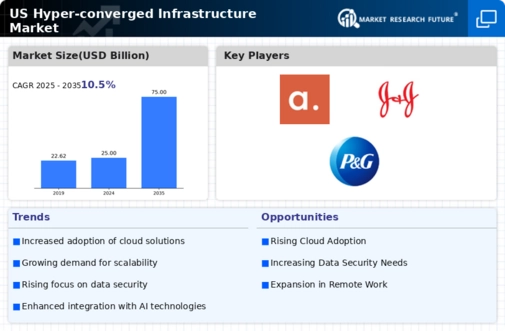Shift Towards Edge Computing
The hyper converged-infrastructure market is being influenced by the shift towards edge computing. As organizations seek to process data closer to the source, the need for efficient, distributed infrastructure becomes apparent. Hyper converged solutions are well-suited for edge environments, providing the necessary agility and performance. This trend is particularly relevant in industries such as manufacturing and retail, where real-time data processing is crucial. The market is expected to expand as more enterprises recognize the benefits of deploying hyper converged infrastructure at the edge, facilitating faster decision-making and improved operational efficiency.
Rising Demand for Scalability
The hyper converged-infrastructure market is experiencing a notable surge in demand for scalable solutions. Organizations are increasingly seeking infrastructure that can grow alongside their business needs. This trend is driven by the necessity for flexibility in resource allocation, allowing companies to efficiently manage workloads. According to recent data, the market is projected to grow at a CAGR of approximately 25% over the next five years. This growth is indicative of a broader shift towards adaptable IT environments, where businesses can seamlessly scale their infrastructure without significant capital expenditure. As enterprises continue to embrace digital transformation, the hyper converged-infrastructure market is likely to play a pivotal role in enabling this scalability.
Growing Importance of Data Analytics
Data analytics is becoming increasingly vital in the hyper converged-infrastructure market. Organizations are leveraging advanced analytics to derive insights from their data, driving informed decision-making. Hyper converged solutions facilitate the integration of analytics tools, enabling businesses to analyze vast amounts of data efficiently. This capability is particularly beneficial in sectors such as e-commerce and telecommunications, where data-driven strategies can lead to competitive advantages. As the demand for real-time analytics continues to rise, the hyper converged-infrastructure market is likely to evolve, offering solutions that cater to the analytical needs of modern enterprises.
Enhanced Disaster Recovery Capabilities
The hyper converged-infrastructure market is witnessing a growing emphasis on robust disaster recovery solutions. Organizations are increasingly aware of the risks associated with data loss and downtime, prompting them to invest in infrastructure that ensures business continuity. Hyper converged solutions offer integrated backup and recovery features, which can significantly reduce recovery time objectives (RTO) and recovery point objectives (RPO). This capability is particularly appealing in sectors where data integrity is paramount, such as finance and healthcare. As businesses prioritize resilience, the hyper converged-infrastructure market is likely to see heightened demand for solutions that enhance disaster recovery capabilities.
Cost Efficiency and Resource Optimization
Cost efficiency remains a critical driver in the hyper converged-infrastructure market. Organizations are increasingly focused on optimizing their IT budgets while maintaining high performance. By consolidating storage, computing, and networking into a single solution, businesses can reduce operational costs significantly. Reports indicate that companies utilizing hyper converged solutions can achieve up to 40% savings in total cost of ownership compared to traditional infrastructure. This financial incentive is compelling, particularly for small to medium-sized enterprises that may have limited resources. As the hyper converged-infrastructure market continues to evolve, the emphasis on cost-effective solutions is expected to intensify, further driving adoption.













Leave a Comment